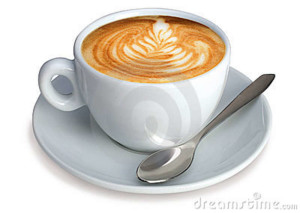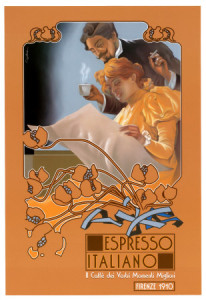A Love Affair With Caffe: Italy’s Espresso Culture
Posted on November 15th, 2013 by Anna in Uncategorized | No Comments »
In Italy, as in Spain and other Mediterranean countries, it is the cultural norm, when one is going out for drinks or dancing with friends, to not leave the house until 11:00 or 12:00 at night—or even 1:00 or 2:00 in the morning, if you want to be really fashionable. Of course, there are plenty of different factors leading to this socially sanctioned night-owlery; many of these cultures involve a mid-day nap, leaving people energized and alert through the wee hours of the night. Most bars don’t have a last call for drinks until 6:00 in the morning or later. During the summer months, it’s best to wait until the sun has gone down for a few hours before it’s cool enough to venture out. But, I am convinced, one of the driving factors behind this phenomenon of late partying lies in Italy’s fondness for drinking espresso.
In English-speaking countries, we’re familiar with espresso, that is, the thick, dark, drink brewed by pressure-forcing a stream of almost boiling water through finely ground coffee beans, mainly as the main ingredient in cappuccinos, lattes, macchiatos, and other milder coffee drinks. But in Italy, espresso—or caffé, as they call is—is commonly drunk black, out of small, white mugs, without milk or even sugar to adulterate its taste. (My first taste of properly brewed, straight espresso in Venice was such a shock, after growing up on overly sugary Starbucks beverages, that I wasn’t sure if the stuff was hot or cold, bitter or sour. However, I was aware of a direct charge of caffeine straight to my system.)
While the first European coffeehouse was opened in Venice in the 17th century and then spread like wildfire across the peninsula, espresso itself was not conceived until much later. Espresso first became Italy’s secondary staple beverage (after wine, of course,) at the beginning of the 20th century, when Desiderio Pavoni bought the patent to the newly-invented espresso machine, which sent a controlled supply of steam and hot water separately through the coffee. As he set up his company, La Pavoni, espresso bars became local hotspots for socializing and recreation—espresso was widely viewed as a way to stimulate conversation and keep one’s energy up. This tradition of cafes as places for social gathering spread throughout Europe and North America along with the Italian diaspora.
Today in Italy, drinking espresso or coffee in general is practically a ritual, and there are very specific rules of etiquette that you should follow. At most espresso bars you’ll see, locals often drink their espresso in two to three quick shots at the bar, right before rushing off to their next engagement; people who sit at tables and savor their beverages are often taken to be tourists. When ordering an espresso in Italy, ask for un caffé, as the term “espresso” is the base ingredient added to coffee beverages, such as a latte, (equal parts steamed milk and espresso,) or a cappuccino (equal parts steamed milk, froth, and espresso—historically, the name comes from the Capuchin friars, who were known for their brown garb and ring of brown hair.) Most importantly of all, it is unheard of to order coffee with milk in it after breakfast, and to ask for a cappuccino any time after mid-morning may earn you some odd looks.
Although today coffee and coffeehouses are ubiquitous, the true aficionado of the Italian coffee culture can always tell the difference between artistically brewed coffee and that of lesser quality. While the cultivation of coffee is thought to have originated in Ethiopia, like so many traditions, Italy has managed to adopt it and perfect it. So the next time you’re grabbing a quick cup of Java on your way to work, remember that you have Italy to thank for your daily caffeine boost.






